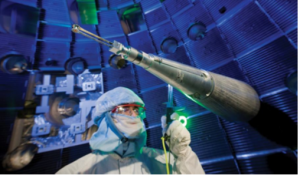
Fusion Leaders Meet for Annual Conference
 A two-day conference on fusion energy took place in Washington D.C. this week, with top fusion scientists from around the country in attendance. Fusion Power Associates (FPA), a leading fusion energy non-profit, hosted the annual event, which is in its 33rd year. The annual meeting is intended for researchers in the fusion community to exchange ideas on the latest research and discuss what is coming in the year ahead.
A two-day conference on fusion energy took place in Washington D.C. this week, with top fusion scientists from around the country in attendance. Fusion Power Associates (FPA), a leading fusion energy non-profit, hosted the annual event, which is in its 33rd year. The annual meeting is intended for researchers in the fusion community to exchange ideas on the latest research and discuss what is coming in the year ahead.
Many of the presentations expressed a sense of frustration, however, due to looming budget cuts from Congress. The ongoing debt negotiations between Congress and the White House will determine how deep to cut discretionary spending, which would impact fusion energy. In an era of scarce fiscal resources, fusion research must compete against other critical science programs for limited science dollars.
Two staff members from congressional appropriations committees spoke to the fusion crowd, delivering a message of tight budgetary constraints. They said that although fusion energy may have significant long-term energy implications, Capitol Hill is more focused on programs that are relevant to the next five or ten years. Since fusion energy is projected to take decades to commercialize, appropriators do not see it as a priority – other science programs take precedence because of their importance for the near-term.
The mood was not all somber though. The fusion community is confident that the internationally-backed ITER project, a fusion reactor under construction in France, will push fusion science forward. ITER, in which the U.S. domestic fusion program plays a crucial role, is expected to produce ten times the amount of power required to be put in, which would be a key milestone on the path to commercialization.
Other presentations at the FPA conference focused on alternative approaches to fusion energy with the objective of shortening the time horizon. Some scientists at MIT believe that by producing smaller fusion reactors in a “modular” fashion – equipping them with the ability to disassemble so that new components can be dropped in – will achieve huge efficiencies in cost, improving the economics of future fusion reactors.
In a broader energy context, fusion scientists are united in their belief that fusion energy can play an indispensable role in resolving America’s long-term energy security. While many analysts and policymakers are enthusiastic about America’s newfound fossil fuel abundance, the fact remains that in the long-term America will need a clean, safe, secure and abundant source of energy.
Fusion energy can meet that goal. However, the timeframe for achieving commercial fusion energy is a function of the level of commitment received at a national level – and successfully accelerating fusion energy development will prove difficult if America’s fusion program is deprioritized in budget negotiations over the next few months and years.






[…] Fusion Leaders Meet for Annual Conference […]